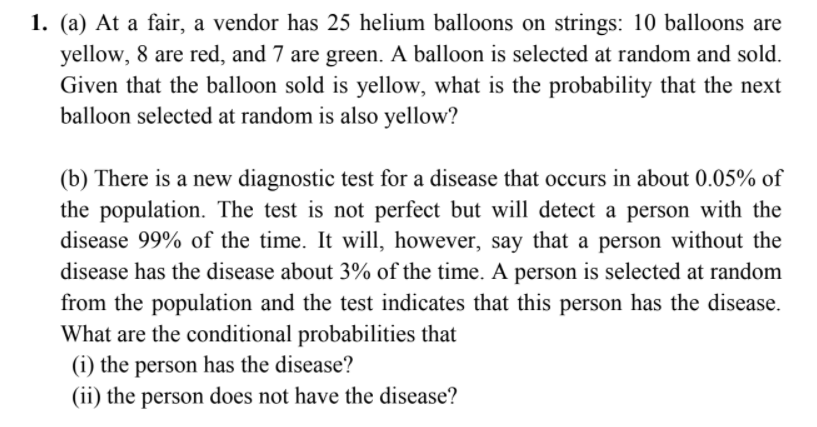a) At a fair, a vendor has 25 helium balloons on strings: 10 balloons are yellow, 8 are red, and 7 are green. A balloon is selected at random and sold. Given that the balloon sold is yellow, what is the probability that the next palloon selected at random is also yellow?
a) At a fair, a vendor has 25 helium balloons on strings: 10 balloons are yellow, 8 are red, and 7 are green. A balloon is selected at random and sold. Given that the balloon sold is yellow, what is the probability that the next palloon selected at random is also yellow?
Holt Mcdougal Larson Pre-algebra: Student Edition 2012
1st Edition
ISBN:9780547587776
Author:HOLT MCDOUGAL
Publisher:HOLT MCDOUGAL
Chapter11: Data Analysis And Probability
Section11.8: Probabilities Of Disjoint And Overlapping Events
Problem 2C
Related questions
Question

Transcribed Image Text:1. (a) At a fair, a vendor has 25 helium balloons on strings: 10 balloons are
yellow, 8 are red, and 7 are green. A balloon is selected at random and sold.
Given that the balloon sold is yellow, what is the probability that the next
balloon selected at random is also yellow?
(b) There is a new diagnostic test for a disease that occurs in about 0.05% of
the population. The test is not perfect but will detect a person with the
disease 99% of the time. It will, however, say that a person without the
disease has the disease about 3% of the time. A person is selected at random
from the population and the test indicates that this person has the disease.
What are the conditional probabilities that
(i) the person has the disease?
(ii) the person does not have the disease?
Expert Solution
This question has been solved!
Explore an expertly crafted, step-by-step solution for a thorough understanding of key concepts.
This is a popular solution!
Trending now
This is a popular solution!
Step by step
Solved in 2 steps

Knowledge Booster
Learn more about
Need a deep-dive on the concept behind this application? Look no further. Learn more about this topic, probability and related others by exploring similar questions and additional content below.Recommended textbooks for you

Holt Mcdougal Larson Pre-algebra: Student Edition…
Algebra
ISBN:
9780547587776
Author:
HOLT MCDOUGAL
Publisher:
HOLT MCDOUGAL


Holt Mcdougal Larson Pre-algebra: Student Edition…
Algebra
ISBN:
9780547587776
Author:
HOLT MCDOUGAL
Publisher:
HOLT MCDOUGAL
